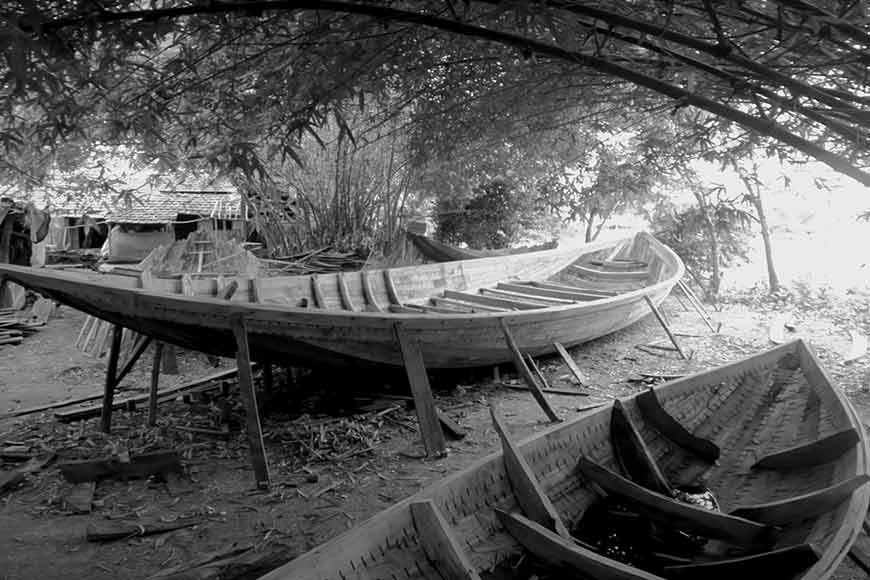Boat Makers of Balagarh --- holding on to 500-year-old craft of hand building ‘engineered’ boats

Balagarh is a non-descript sleepy hamlet, situated 115 km North of Kolkata, by the river Hooghly. It is the heart of Bengal’s indigenous boat manufacture. The center where the boat makers and workshops still uphold a centuries-old tradition is centered around Sripur market. The craft is at least 500 years old, with the boat makers of Sripur getting a mention in the writings of even Abul Fazal (1551-1602).

Way back in the 16th-century, rivers were the lifeline of trade and business. Adi Saptagram, on the Saraswati River, a distributary of the Hooghly was connected directly with the Bay of Bengal and used to be a busy river port. It was about 20 km south of Balagarh and local merchants used the port for conducting trade with countries as far as Sri Lanka, Burma, the Indonesian archipelago and other places.


The demand for boats was immense and Balagarh’s craft plied every part of the Mughal Empire’s richest province, which included today’s Bihar and Odisha along with the old undivided Bengal. Rajbongshi wood craftsmen from Balagarh att¬ended to them. Over the years, these craftsmen learnt boat-making and built boats for rivers as well as for seafarers. Interestingly, The Boat Makers of Balagarh used only Salwood earlier because of its sturdy quality but now they use Babla, kapur and shirishtoo. During monsoons, some fly-by-night boat builders use inferior quality wood as they lack funds to buy good quality wood.

But to this day, they do not use modern technology. The tools are the same as those used 500 years ago. Measurements are still made with string and stick, the result checked by experienced eyes. The end product, however, is precisely engineered and even the most perfectionist can find no flaw in the product. The primary spine that grows slowly into a boat is called the ‘daNra’. The planks are shaped by heating and pressing, then placed side by side and fixed by small iron nails. Measurements are taken at each step. When the work is done its accuracy is crosschecked and any extra parts are axed or sawed.

A boat is measured by “hands”. One hand = 45 cm. Boats may be from 10 hands (15 feet) to 28 hands (42 feet) or more. They are used mainly to transport sand, coal, etc., or for fishing and ferrying people. Monsoon brings business, but also sprouts fly-by-night crooks who hammer out a dingi nouko in less than 10 days with inferior wood. Balagarh’s boat-makers find it hard to compete with these cons as they traditionally use only hardwood like sal or teak but are now forced to accept cheaper varieties. The primary markets for boats from Balagarh are Bihar, Jharkhand and neighbouring Bangladesh and Bengal itself. But the trade is no longer viable as the margins are very small. A 10-foot boat takes three to four days to make with two fully dedicated craftsmen and requires an investment of Rs 7,000. The sale price is just Rs 8000. This is driving down earnings and causing plight of boatmen. But the workers continue to hope that their skill will not die out.

In 1952, Balagarh rolled out its first motor-boat and next year, the first motor vessel. Today it is an industry in decline but there are some 25 small workshops providing livelihood to about 150 families. Just 30 years ago, there were 75 workshops. These are highly skilled workers, but they make between Rs 200 and Rs 300 a day, the going rate for unskilled work. So, many people have migrated to other states, even to the Andaman and Nicobar Islands. Many work as boat repairers along the Hooghly and in the Sundarbans.

The boat makers however got a boost when the State Government placed orders for wooden boats for the floating market at Patuli. The government’s decision to replace 15,000 bhutbhutis – as the mechanized country boats are called – plying in the state waterways, under its Jaldhara project holds additional promise. The project aims to prevent accidents due to capsizing of country boats. The government also offers Rs 1 lakh subsidy to boatmen replacing their bhutbhutis. And the die-hards among them vow to turn timber into sturdy boats “as long as there is water in the rivers, lakes and the seas…” With their whole life invested in their craft, they believe their faith will keep them afloat.









